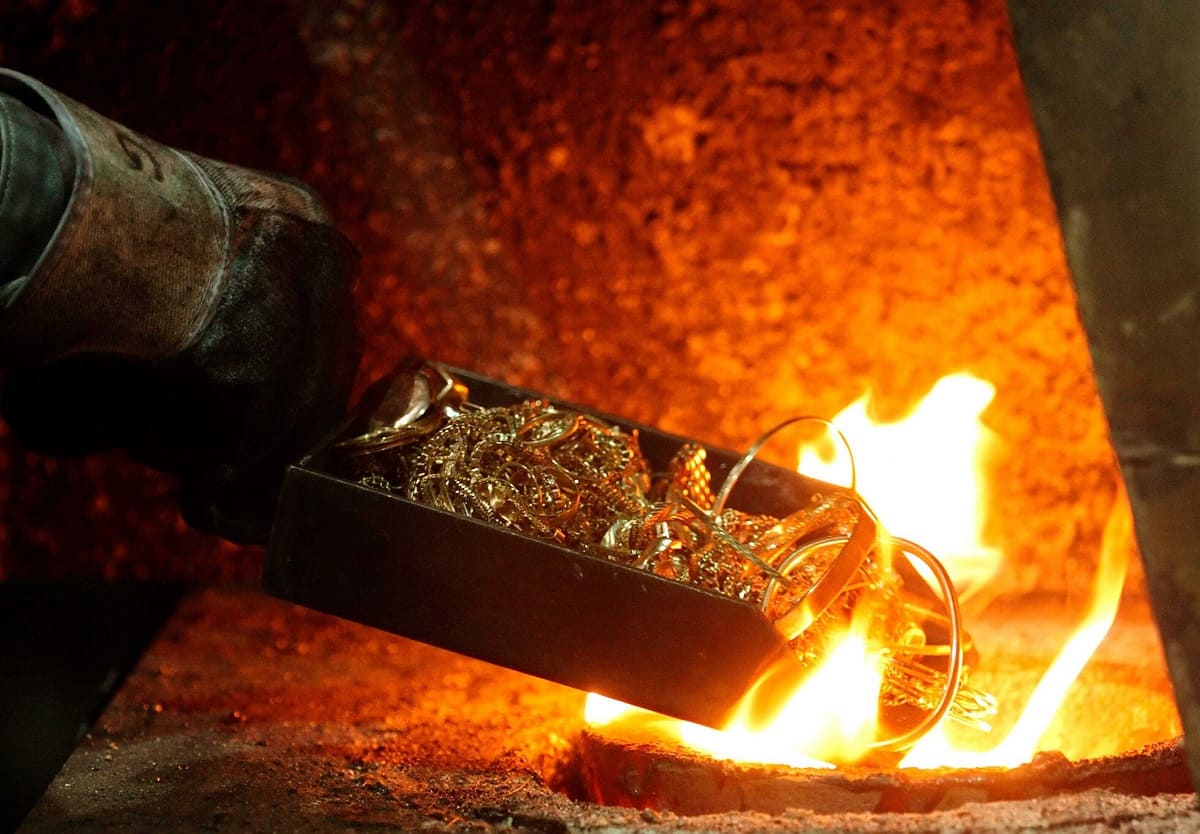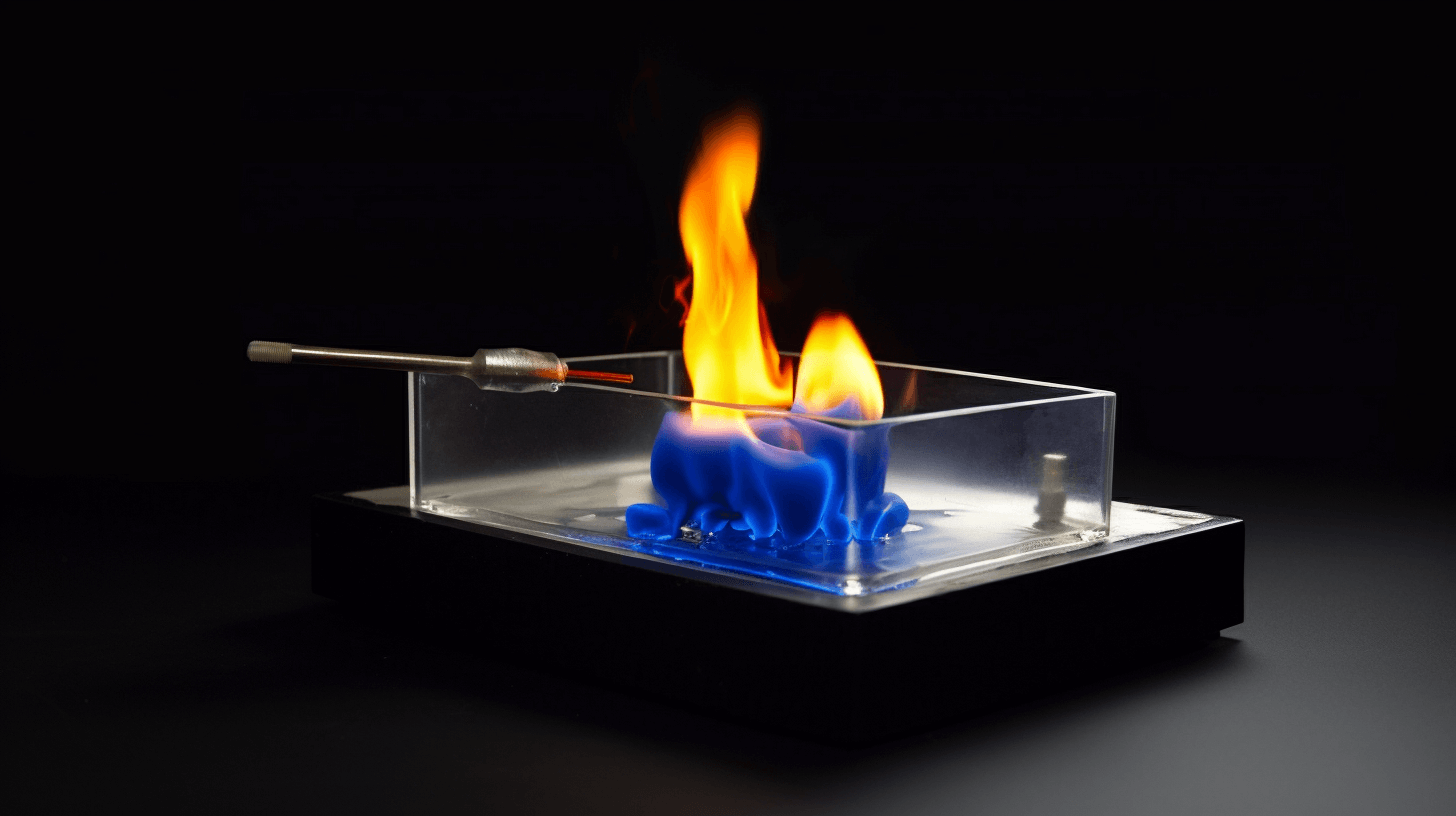Home>Science & Environment>Melting Temperatures Of Gold: A Comprehensive Guide


Science & Environment
Melting Temperatures Of Gold: A Comprehensive Guide
Published: February 19, 2024
Discover the melting temperatures of gold and gain a comprehensive understanding of this vital scientific aspect. Explore the intersection of science and the environment in this informative guide.
(Many of the links in this article redirect to a specific reviewed product. Your purchase of these products through affiliate links helps to generate commission for Temperatures.com, at no extra cost. Learn more)
Table of Contents
Introduction
Gold, a precious metal revered for its lustrous beauty and enduring value, possesses a melting temperature that has fascinated scientists, artisans, and enthusiasts for centuries. The melting point of gold, which is the temperature at which it transitions from a solid to a liquid state, is a fundamental property that underpins its diverse applications across various industries and its allure in the realm of art and jewelry.
Understanding the melting temperature of gold is not only of scientific interest but also holds practical significance in fields such as metallurgy, jewelry making, and electronics manufacturing. This comprehensive guide delves into the factors influencing the melting point of gold, its historical significance, industrial applications, methods for determining its melting temperature, and the variations observed across different purity levels.
Gold's melting temperature is a captivating subject that invites exploration into the intricate interplay of physical and chemical forces at the atomic level. As we embark on this journey to unravel the mysteries surrounding the melting point of gold, we will gain a deeper appreciation for the remarkable properties that have elevated gold to a status of unparalleled significance in human history and modern society.
Factors Affecting the Melting Point of Gold
The melting point of gold, a defining characteristic of this noble metal, is influenced by a myriad of factors rooted in its atomic structure and bonding behavior. Understanding these factors is crucial for comprehending the remarkable stability and enduring nature of gold at high temperatures.
-
Atomic Structure: Gold's melting point is intricately linked to its atomic structure. With a dense, closely packed arrangement of atoms, gold exhibits strong metallic bonding, which contributes to its high melting temperature. The cohesive forces between the gold atoms necessitate a substantial input of energy to disrupt the metallic lattice and induce the transition from a solid to a liquid state.
-
Purity: The purity of gold, often expressed in karats, significantly impacts its melting point. Pure gold, with a purity of 24 karats, has a higher melting temperature compared to alloys or lower purity gold. This is attributed to the presence of impurities and other metals in lower purity gold, which can disrupt the uniformity of the atomic lattice and reduce the cohesive forces, thereby lowering the melting point.
-
Pressure: While pressure's influence on gold's melting point is not as pronounced as in other materials, it still plays a role. Under high pressure, the atoms in the gold lattice are forced closer together, leading to an increase in the strength of metallic bonding and consequently elevating the melting point.
-
Crystal Structure: The crystal structure of gold, specifically its face-centered cubic arrangement, contributes to its high melting point. This arrangement allows for efficient packing of atoms, resulting in strong metallic bonding and a correspondingly high melting temperature.
-
Alloying Elements: When gold is alloyed with other metals, such as silver, copper, or palladium, the melting point of the resulting alloy is altered. The presence of these alloying elements can modify the atomic arrangement and bonding characteristics, leading to variations in the melting temperature compared to pure gold.
-
Size of Gold Nanoparticles: At the nanoscale, the melting point of gold nanoparticles deviates from that of bulk gold. Quantum confinement effects and surface energy considerations influence the melting behavior of gold nanoparticles, making their melting point size-dependent and distinct from that of macroscopic gold.
The interplay of these factors underscores the intricate nature of gold's melting point, shedding light on the remarkable stability and enduring nature of this precious metal even under extreme thermal conditions.
Historical Significance of Gold's Melting Temperature
The historical significance of gold's melting temperature is deeply intertwined with the evolution of human civilization and the enduring allure of this precious metal. Dating back to antiquity, the mastery of gold's melting point has been pivotal in shaping the course of human history, influencing cultural, economic, and technological developments across diverse societies.
In ancient civilizations, the ability to manipulate gold through controlled heating and casting processes marked a significant milestone in the advancement of metallurgical knowledge. The discovery and mastery of gold's melting temperature enabled artisans and craftsmen to transform raw gold nuggets into intricate ornaments, ceremonial artifacts, and symbolic objects of power and prestige. The art of goldsmithing, characterized by the precise application of heat to mold and shape molten gold, became a revered craft, embodying the fusion of artistic expression and scientific understanding.
The historical significance of gold's melting temperature extends beyond the realms of art and adornment. Gold's malleability and resistance to corrosion, coupled with its high melting point, rendered it indispensable in the minting of coins and the establishment of monetary systems in ancient civilizations. The ability to accurately determine and manipulate gold's melting temperature was instrumental in ensuring the purity and authenticity of coinage, thereby underpinning the stability and trustworthiness of economic transactions.
Furthermore, the symbolic and cultural significance of gold's melting temperature is evident in the rituals and traditions of diverse societies. From ceremonial offerings and religious artifacts to regal adornments and burial practices, the mastery of gold's melting point has been synonymous with the expression of wealth, power, and spiritual reverence throughout history.
The enduring fascination with gold's melting temperature transcends time and continues to resonate in modern society. The historical legacy of gold as a symbol of prosperity, prestige, and permanence is intricately linked to the mastery of its melting point, which has left an indelible imprint on the annals of human civilization.
In essence, the historical significance of gold's melting temperature serves as a testament to the ingenuity, creativity, and cultural significance that have been woven into the fabric of human experience, shaping the narrative of gold as a timeless symbol of beauty, wealth, and enduring value.
Industrial Applications of Gold's Melting Point
The remarkable melting point of gold has paved the way for a diverse array of industrial applications, harnessing its unique properties to drive innovation and technological advancement across various sectors. One of the primary industrial applications of gold's melting point lies in the realm of electronics and semiconductor manufacturing. Gold's exceptional conductivity, coupled with its resistance to corrosion and oxidation, makes it an indispensable material for the production of high-performance electrical contacts and connectors. By leveraging gold's high melting point, which ensures the durability and stability of these components under demanding operating conditions, the electronics industry has been able to achieve enhanced reliability and longevity in electronic devices and circuitry.
Furthermore, the aerospace and aviation sectors have capitalized on gold's melting temperature to fabricate critical components for spacecraft, satellites, and high-temperature applications. The ability of gold to withstand extreme thermal environments, coupled with its excellent reflectivity and thermal conductivity, has positioned it as a preferred material for thermal control coatings, radiation shields, and propulsion system components. By harnessing gold's high melting point, aerospace engineers and manufacturers have been able to ensure the integrity and performance of vital equipment in the harsh conditions of outer space and high-altitude environments.
In the field of medical technology, gold's melting point has found application in the production of precision instruments, such as thermocouples and medical implants. The biocompatibility and inertness of gold, combined with its high melting temperature, make it an ideal candidate for manufacturing implants and devices that require long-term stability and resistance to degradation within the human body. Moreover, the use of gold in thermocouples, which rely on its consistent melting behavior at high temperatures, has facilitated accurate temperature measurements in medical and laboratory settings, contributing to advancements in research, diagnostics, and treatment modalities.
Additionally, the jewelry and luxury goods industry relies on gold's melting point to craft exquisite ornaments, fine jewelry, and decorative artifacts. The ability to manipulate gold at its precise melting temperature enables artisans and designers to create intricate and enduring pieces that showcase the timeless allure and elegance of this precious metal. By harnessing the malleability and lustrous appeal of molten gold, craftsmen are able to imbue their creations with a sense of artistry and sophistication, catering to discerning clientele who value the intrinsic beauty and enduring value of gold.
In essence, the industrial applications of gold's melting point underscore its indispensable role in driving technological innovation, enhancing product performance, and enriching human experiences across diverse domains. The enduring significance of gold's melting temperature in industrial applications serves as a testament to the enduring legacy of this noble metal as a catalyst for progress and ingenuity in the modern era.
Methods for Determining the Melting Temperature of Gold
The determination of gold's melting temperature is a critical endeavor that necessitates precise and reliable methods to ascertain this fundamental property with accuracy. Several techniques have been employed to elucidate the melting point of gold, each offering unique insights into the thermal behavior of this noble metal.
-
Differential Scanning Calorimetry (DSC): DSC is a widely utilized method for determining the melting temperature of materials, including gold. This technique involves subjecting a small sample of gold to controlled heating while measuring the heat flow into or out of the sample. The characteristic endothermic peak observed in the DSC thermogram corresponds to the melting point of gold, providing a quantitative assessment of its thermal transition from solid to liquid state.
-
Optical Microscopy: Optical microscopy serves as a valuable tool for visualizing the melting behavior of gold at the microscopic level. By employing polarized light microscopy or differential interference contrast microscopy, researchers can observe the structural changes and phase transitions occurring in gold as it undergoes melting. This method offers valuable qualitative insights into the morphological evolution of gold during the melting process, complementing quantitative measurements obtained through other techniques.
-
High-temperature X-ray Diffraction (HT-XRD): HT-XRD enables the in-situ investigation of gold's crystallographic changes at elevated temperatures. By subjecting a gold sample to intense heat within the X-ray diffractometer, researchers can monitor the alterations in the lattice parameters and crystal structure as the material approaches its melting point. The diffraction patterns obtained during heating provide crucial information about the thermal stability and phase transformations of gold, aiding in the precise determination of its melting temperature.
-
Laser Heating Techniques: Laser-based methods, such as laser flash photometry and laser heating microscopy, offer non-contact and rapid means of determining the melting temperature of gold. By focusing a high-intensity laser beam on a gold sample, the temperature-induced changes in reflectivity, emissivity, or optical properties can be monitored to identify the onset of melting. These techniques provide real-time data on the thermal response of gold, facilitating the accurate determination of its melting point under dynamic heating conditions.
-
Differential Thermal Analysis (DTA): DTA involves comparing the temperature of a gold sample to that of an inert reference material as both are subjected to controlled heating. The temperature difference between the sample and reference material during heating or cooling cycles reveals characteristic peaks associated with phase transitions, including the melting of gold. DTA serves as a robust method for quantifying the melting temperature and enthalpy of fusion of gold, offering valuable thermodynamic insights into its solid-liquid transition.
These methods collectively contribute to a comprehensive understanding of gold's melting temperature, enabling researchers and practitioners to harness this knowledge for diverse scientific, industrial, and technological pursuits. The meticulous determination of gold's melting point through these methodologies underscores the precision and ingenuity employed in unraveling the thermal characteristics of this esteemed metal.
Variations in Gold's Melting Point Across Different Purity Levels
The purity of gold, often denoted in karats, plays a pivotal role in determining its melting point, with distinct variations observed across different purity levels. Pure gold, known as 24-karat gold, is renowned for its exceptional resistance to corrosion and its enduring luster, attributes that stem from its high purity and inherent stability at elevated temperatures. As the purity of gold diminishes due to the incorporation of alloying elements, such as silver, copper, or palladium, the melting point undergoes discernible alterations, reflecting the influence of impurities on the cohesive forces within the metallic lattice.
At its highest purity of 24 karats, gold exhibits a melting point of approximately 1,064 degrees Celsius (1,947 degrees Fahrenheit), showcasing its remarkable resilience to thermal degradation. The absence of impurities in pure gold facilitates strong metallic bonding, necessitating a substantial input of energy to disrupt the cohesive forces and induce the phase transition from solid to liquid. This elevated melting temperature underscores the intrinsic stability and enduring nature of pure gold, rendering it an ideal choice for applications that demand uncompromising quality and resistance to heat-induced deformations.
In contrast, lower purity gold alloys, such as 18-karat or 14-karat gold, feature reduced melting points due to the presence of alloying elements that disrupt the uniformity of the atomic lattice. The incorporation of metals like silver or copper introduces atomic irregularities and interstitial spaces within the gold matrix, thereby diminishing the strength of metallic bonding and lowering the cohesive forces that uphold the solid structure. Consequently, the melting temperature of these alloys is correspondingly reduced, ranging from approximately 960 to 990 degrees Celsius (1,760 to 1,814 degrees Fahrenheit) for 18-karat gold and 860 to 890 degrees Celsius (1,580 to 1,634 degrees Fahrenheit) for 14-karat gold.
The variations in gold's melting point across different purity levels underscore the intricate interplay between purity, atomic structure, and cohesive forces, elucidating the impact of alloying elements on the thermal properties of this noble metal. These insights are instrumental in guiding the selection of gold alloys for specific applications, where considerations of malleability, workability, and thermal stability are paramount. By discerning the nuanced variations in melting temperature associated with different purity levels, artisans, manufacturers, and researchers can leverage this knowledge to optimize the performance and characteristics of gold-based materials across diverse industrial and artistic domains.
Conclusion
The melting temperature of gold, a defining characteristic that encapsulates its enduring allure and remarkable properties, serves as a testament to the profound interplay of scientific, historical, and industrial significance woven into the fabric of this noble metal. From the intricate atomic forces governing its solid-liquid transition to the enduring legacy of its mastery throughout human history, gold's melting point stands as a symbol of resilience, creativity, and enduring value.
The comprehensive exploration of the factors influencing gold's melting point has unveiled the intricate interplay of atomic structure, purity, pressure, crystal arrangement, alloying elements, and size-dependent effects, illuminating the multifaceted nature of this fundamental property. This understanding not only enriches our scientific knowledge but also underscores the enduring stability and enduring nature of gold, positioning it as a cornerstone of innovation and creativity across diverse domains.
Delving into the historical significance of gold's melting temperature has unveiled its pivotal role in shaping the cultural, economic, and technological landscapes of ancient and modern societies. From the art of goldsmithing to the establishment of monetary systems and the embodiment of wealth and prestige, the mastery of gold's melting point has left an indelible imprint on the annals of human civilization, resonating as a timeless symbol of prosperity and ingenuity.
The industrial applications of gold's melting point have underscored its indispensable role in driving technological innovation, enhancing product performance, and enriching human experiences across diverse domains. From electronics and aerospace to medical technology and luxury goods, gold's high melting temperature has catalyzed advancements, offering unparalleled reliability, durability, and aesthetic appeal in a myriad of applications.
The meticulous methods employed for determining gold's melting temperature have exemplified the precision and ingenuity harnessed in unraveling the thermal characteristics of this esteemed metal, providing valuable insights for scientific, industrial, and technological pursuits. These methodologies have not only facilitated the accurate determination of gold's melting point but have also deepened our understanding of its thermal behavior at the atomic level.
Moreover, the variations in gold's melting point across different purity levels have shed light on the nuanced interplay between purity, atomic structure, and cohesive forces, offering valuable guidance for the selection and optimization of gold alloys in diverse applications.
In essence, the exploration of gold's melting temperature transcends the realms of science, history, and industry, encapsulating the enduring legacy of this noble metal as a symbol of resilience, creativity, and enduring value. As we conclude this comprehensive guide, we are reminded of the timeless allure and enduring significance of gold's melting point, which continues to inspire and captivate across the tapestry of human endeavors.














